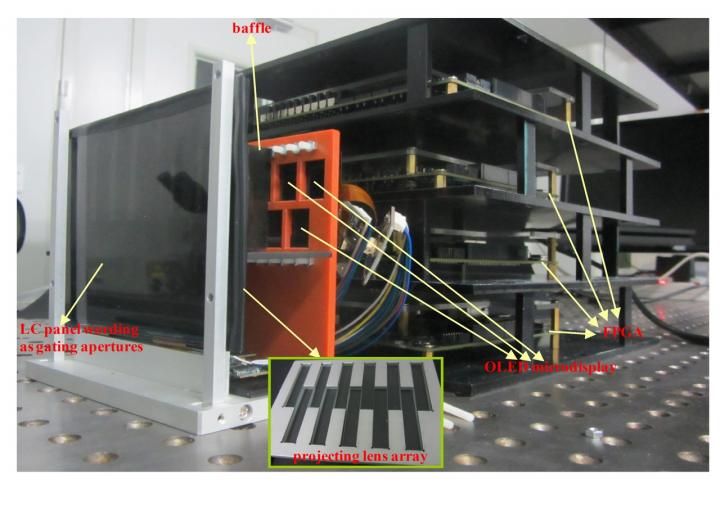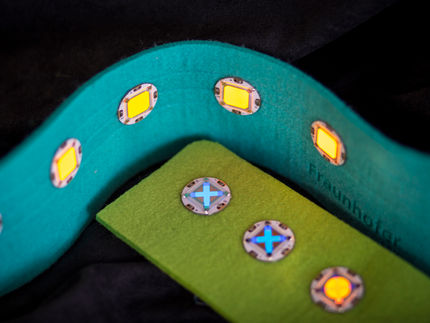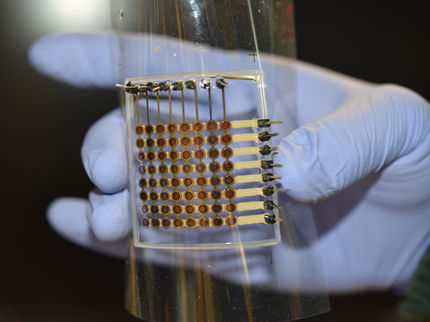Shrinking 3-D technology for comfortable smart phone viewing
Imagine watching a 3D movie on your smart phone and suddenly getting a headache or even feeling nauseous. Such viewer discomfort is one of the biggest obstacles preventing widespread application of 3D display technology - especially for portable devices whose slim design poses an extra challenge.

A super multi-view (SMV) system with comfortable 3-D effects, constructed by a group of OLED microdisplay/projecting lens pairs, is proposed in this paper. Through gating different segments of each projecting lens sequentially and refreshing the virtual image of the corresponding microdisplay synchronously, the proposed SMV system greatly decreases the demand on the number of employed microdisplays and at the same time takes a thin optical structure, endowing great potential for portable devices.
Dongdong Teng
Now researchers at the Sun Yan-Sen University, China have developed a new display with comfortable 3D visual effects. The device is based on a "super multi-view technique" which works to reduce viewer discomfort. It also greatly decreases the required number of microdisplays, which makes a compact design possible.
"There are many causes for 3D-viewing discomfort, but the most substantial one is the vergence-accomodation conflict," said Lilin Liu, author and an associate professor of the State Key Lab of Optoelectronics Materials and Technology, Sun Yat-Sen University, China. She explained that vergence-accomodation conflict is a mismatch between the point at which the eyes converge on an image and the distance to which they focus when viewing 3D images.
Human eyes are separated by about six centimeters, which means that when we look at an object, the two eyes see slightly different images. Our brain directs both eyes to the same object and the distance at which the eyes' sight lines cross is technically called "vergence distance." Meanwhile, our brain adjusts the focus of the lens within each eye to make the image sharp and clear on the retina. The distance to which the eye is focused is called "the accommodative distance." Failure to converge leads to double images, while mis-accommodation results in blurry images.
In natural viewing, human's vergence and accommodation responses are correlated with each other and adjust simultaneously. In other words, vergence and accommodation distance are almost always the same -- that's why we can always see an object clearly and comfortably.
Conventional 3D displays try to mimic the natural viewing by creating images with varying binocular difference, which simulates vergence changes in the natural 3D landscape. But the accommodative distance remains unchanged at the display distance, resulting in the so-called vergence-accomodation conflict that causes viewer discomfort.
"Conventional 3D displays usually deliver some views of the displayed spatial spot to a single eye pupil. That is why accommodative distance remains fixed on the display screen and cannot adjust simultaneously as vergence distance does, causing vergence-accomodation conflict," said Liu.
The team's solution is to project numerous 2D perspective views to viewpoints with intervals smaller than the pupil diameter of the eye. This means the device can deliver at least two different views to a single eye pupil.
"Our proposed scheme overcomes vergence-accomodation conflict by delivering more than two views to a single eye pupil, making the eyes focus on the displayed image naturally. Also, the prototype in our study is 65-millimeter-thin, and the system could become thinner with improvement in structural elements, which provides a demo for comfortable 3D wearable electronics or portable displays," said Dongdong Teng, co- author of the paper.
The team's prototype system consists of 11 elementary projecting units. Each projecting unit is constructed by an organic light-emitting diode (OLED) microdisplay, a rectangular projecting lens, two vertical baffles and a group of gating apertures (liquid crystal panel) attached to the projecting lens. By gating different gating apertures in sequence and refreshing the virtual image of the corresponding microdisplay synchronously, the researchers can obtain dense viewpoints on the display screen.
"Creating a dense arrangement of viewpoints on the display screen is the key to comfortable 3D effect," Liu noted.
To test viewers' reactions to the prototype system, eight subjects were asked to observe a displayed 3D image of an apple in the lab environment and no headache or discomfort was reported.
Moreover, as the gating aperture array is adhered to the projecting unit array, the size of the prototypestructure is thin, around 65 millimeters, which is promising for applications in portable devices.
Liu said adjustments to the device could make it even thinner, which is a focus of their future work.
"The novelty and the main merit of our super multi-view system lie in the thin structure. To the best of our knowledge, this is the first report of a 'super multi-view system' with thin structure, which makes it suitable for portable electronics such as smart phones and wearable devices," Liu said.

































































